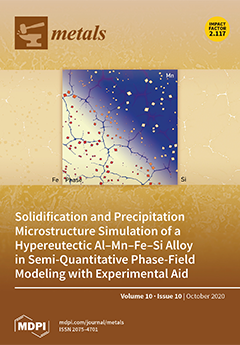Ceramic-metal composites with novel performance are desirable materials; however, differences in their properties result in difficulties in joining. In this study, the joining of metal to ceramic is investigated. We recently succeeded in causing super-spread wetting on the surface fine crevice structures of
[...] Read more.
Ceramic-metal composites with novel performance are desirable materials; however, differences in their properties result in difficulties in joining. In this study, the joining of metal to ceramic is investigated. We recently succeeded in causing super-spread wetting on the surface fine crevice structures of metal surfaces produced by both laser irradiation and reduction-sintering of oxide powders. In this work, joining copper onto an Al
2O
3 plate was achieved by taking advantage of super-spread wetting. Fe
2O
3 powder was first sintered under reducing conditions to produce a microstructure which can cause super-spread wetting of liquid metal on an Al
2O
3 plate. A powder-based surface fine crevice structure of metallic iron with high porosity was well-formed due to the bonding of the reduced metallic iron particles. This structure was joined on an Al
2O
3 plate with no cracking by the formation of an FeAl
2O
4 layer buffering the mismatch gap between the thermal expansion coefficients of iron and Al
2O
3. We successfully achieved metalizing of the Al
2O
3 surface with copper without interfacial cracks using super-spread wetting of liquid copper through the sintered metallic iron layer on the Al
2O
3 plate. Then, laser irradiation was conducted on the surface of the copper-metalized Al
2O
3 plate. A laser-irradiated surface fine crevice structure was successfully created on the copper-metalized Al
2O
3 plate. Moreover, it was confirmed that the super-spread wetting of liquid tin occurred on the laser-irradiated surface fine crevice structure, finally accomplishing the joining of a copper block and the copper-metalized Al
2O
3.
Full article





